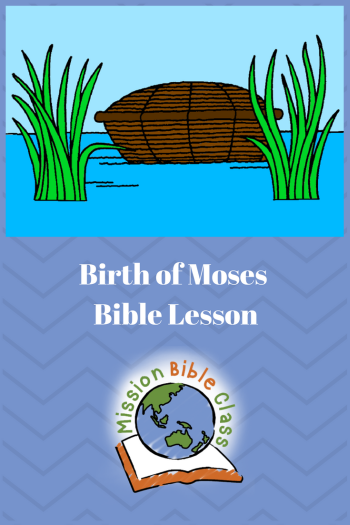 Scripture Reference:
Scripture Reference:![]()
Exodus 1:1-2:10
Suggested Theme:
God loves and protects His children. Family members should love and protect each other too.
Memory Verse: “This is my command: Love each other as I have loved you.” John 15:12, ICB
Story Overview:
Almost 400 years had passed since Joseph’s family, the Israelites, moved to Egypt. They were now slaves, and the current Pharaoh worried they had become so numerous. He ordered the deaths of all baby boys born to them. One mother, Jochebed, placed her infant son, Moses, in a basket and hid him among the reeds along the Nile River. Pharaoh’s daughter discovered him and raised him as her son.
Background Study:
Children often relate easily to the family in this story because they are familiar with parents and siblings and how a family functions together. In sharp contrast to the family dysfunction we learned about in some of the later Genesis stories (such as Jacob, Esau and the Birthright, and Joseph Sold By His Brothers), here we see that Moses was born into a family that, by all appearances, seemed to care very much for each other.
Moses’ mother was Jochebed, and his father Amram (as we later learn Exodus 6:20; Numbers 26:59). At the time of Moses’ birth, this couple already had a daughter, Miriam, and a three-year-old son, Aaron (calculated from Exodus 7:7). Jochebed and Amram were descendants of Levi who was one of the twelve sons of Israel.
The children in this family would eventually play important roles in the Exodus. The tribe of Levi will later be assigned a priestly role, with Moses’ brother, Aaron, becoming the first priest (Exodus 28:1-5). Miriam will eventually become one of only a few women in the Bible who are referred to as prophets (Exodus 15:20-21).
Names for God’s People:
In Exodus and, in fact, throughout the Bible, God’s people are referred to by various names. Earlier in Genesis 12:2, we learn that God chose Abraham to become the father of a great nation that would bless the peoples of the earth.
- Israelites: The name of Abraham’s grandson, Jacob, was changed to “Israel” in Genesis 32:27-28) and his descendants are sometimes called “Israelites.”
“This king said to his people, “Look! The people of Israel are too many! And they are too strong for us to handle!” Exodus 1:9, ICB - Hebrews: “Abram the Hebrew” is mentioned in Genesis 14:13. Although there are a few different possible origins for this name, it is usually used by foreigners (biblestudytools.com).
“So the king commanded all his people: ‘Every time a boy is born to the Hebrews, you must throw him into the Nile River. But let all the girl babies live.’” Exodus 1:22, ICB - Jews: This term was not used until long after Moses’s time, and the term varies among translations. The Book of Daniel records events that took place in Babylon during the captivity. In Daniel 3:8, God’s people were referred to as “men of Judah” in the International Children’s Bible (ICB). The same phrase is translated as “Jews” in many other versions of the Bible.
Four hundred years had passed since Pharaoh had so admired Joseph and invited Joseph’s family to come and live in Egypt. At that time, the family numbered only seventy people in all (Genesis 46:27). Judging by the references later given, we can assume that that number, including women and children, would now easily exceed a million (Exodus 12:37). Over these four hundred years the status of the Israelites had fallen from honoured guests to despised slaves. They were treated ruthlessly and forced to work hard.
And yet their numbers increased and Pharaoh feared them. The killing of baby boys would have been one way to prevent boys from possibly growing up to become fighting rebels. When midwives refused to follow his direction and act as executioners, Pharaoh put out a general command that anyone spotting a baby boy Israelite was to throw him into the Nile River. This was an extremely dangerous time for a boy to be born.
Jochebed must have been desperate to protect her baby, but how long can a baby in a house remain hidden from the community? At three months, she waterproofed a basket and floated him among the reeds at the edge of the Nile River. The family’s care for this child can be seen in how big sister Miriam stood guard over her brother from a distance.
The baby was spotted when the Pharaoh’s daughter came to the river to bathe. She knew the baby was a Hebrew and would have been under Pharaoh’s command to throw Hebrew baby boys into the Nile. And yet she felt sorry for him.
Miriam bravely approached and offered to find someone to take care of the infant. Of course, that “someone” was actually Jochebed. Pharaoh’s daughter offered to pay her to nurse Moses until he was old enough for her to take to live in the palace as her adopted son. In this way, Moses was allowed to live with his own family during the first few years of his life.
Way to Introduce the Story:
Older children could look up Egypt on a map. Bring books from the public library or National Geographic Magazines to show pictures of the Nile River. Discuss what it would be like on the edge of a river. There would be squishy mud and reeds. Ask younger children if they have ever been to a river or if they have ever stepped in mud. “Today’s story from the bible takes place right beside a river.”
topThe Story:
Many years ago, God’s people lived in tents in Egypt. At first, they had moved there as special guests of the Pharaoh. Their ancestor, Joseph, had saved the whole country from a great famine.
But now, 400 years later, the memories of Joseph and the old Pharaoh had long since faded. The current Pharaoh did not like that there were so many Israelites living in his country. He thought, “What if we are attacked by enemies? There are so many Israelites that they might take the side of the enemies and fight against Egypt.”
So, the Pharaoh thought of a plan to make the Israelites weak. He told his leaders that the Israelites were now going to be slaves in Egypt. They would have to work very hard but never get paid. The Israelites were forced to carry large stones and build huge buildings. They were treated very badly.
Even though they were treated so badly, Pharaoh’s plan to make them weak did not work. Still, the population of the Israelites increased. More and more children were born.
Pharaoh was so angry that he thought up another plan to stop the number of Israelites from increasing.
Two women were midwives who helped the Israelite mothers when they were having babies. Pharaoh called the women before him and said, “Every time when you are helping a mother and she gives birth to a boy, I want you to kill the baby boy right away.”
“Now I will stop the boys growing up to fight against me,” Pharaoh thought to himself.
But, once again, the plan did not work. The midwives tricked Pharaoh and told him that they could never make it there in time to kill the baby boys.
Pharaoh was furious! He now made a new law that was terrible. He told everyone in Egypt that if they saw a baby boy among the Israelites, they were to take the baby boy and throw him into the Nile River so that he would die.
Of all the times to have a baby boy, this was probably the worst. But this is when Jochebed and her husband, Amram, gave birth to their third child. He was a boy, and his name was Moses. Amram and Jochebed loved Moses. His big sister, Miriam, and big brother, Aaron, loved Moses too.
They did not want anyone to take him and kill him! For three months, they hid baby Moses so no one knew they had a baby boy. But babies cannot be hidden in a house for long. A baby cries and crawls and soon the neighbours would know he was there.
So, Jochebed had her own plan to protect Moses. She made a basket out of papyrus (the plants that grow by the river). Then,, she covered the basket with thick tar to make it waterproof. She was making a basket that could float.
Jochebed put the baby in the basket at the edge of the river. Moses’ big sister, Miriam, stayed nearby. Maybe no one would find the baby hidden in the reeds.
But someone did find Moses. Of all the people who might have found him, it was the Pharaoh’s own daughter. Her handmaid brought the baby to her. Little Moses was crying, and she felt sorry for him.
She knew the baby was an Israelite, but even though her father had commanded everyone in Egypt to throw Israelite babies into the Nile River, she wanted to keep him.
Moses’ big sister, Miriam, was watching as all of this happened. Bravely, Miriam approached the princess and said someone would need to take care of the baby since he was so small. Miriam asked if the princess would like her to go and find an Israelite woman to be like a caregiver or nurse to the baby.
The pharaoh’s daughter thought this was a good idea. The princess said she would like to pay a woman to do all of that work. When the baby got older, he could come and live in the palace with her. So, who do you think Miriam brought back to the princess? It was their very own mother!
God helped Moses’ family take care of him and protect him. Moses stayed in their house with them until he was big enough to live in the palace with the princess.
Even though Pharaoh had all kinds of plans to hurt God’s people, God knew that someday Moses would be a great leader of his people. Even though there was danger everywhere else, Moses grew up safely in the palace where the Pharaoh lived.
topWays to Tell the Story:
This story can be told using a variety of methods. Always remain true to the facts found in the Bible but help children connect to its meaning by using drama, visual aids, voice inflection or other group participation.
Click here for visual aids and story-telling methods.
Download the slideshow or print the pictures. Each teacher is unique, so only use the illustrations that best relate to the way you are telling the story in this lesson. Too many illustrations can be confusing, so eliminate any that cover other stories or details you do not wish to emphasise in this lesson.
Review and Reflection Questions:
Review questions help children remember and know the facts of a story, while reflection questions encourage them to internalize its meaning and implications for their lives. Asking at least one of each type of question can help strengthen a child’s spiritual development and help them connect to God. Click here to learn more about review and reflection questions.
Review:
- Why did the new Pharaoh hate the Israelites? (Because there were so many of them, he thought they might join with Egypt’s enemies and fight against Egypt)
- How did the Pharaoh treat the Israelites? (He made them slaves and made them work very hard. He was cruel to them)
- What did the Pharaoh tell everyone to do if they saw a baby Israelite boy? (They were to throw them into the river to die)
- What were the names of Moses’ family members? (Amram (father), Jochebed (mother), Aaron (brother), and Miriam (sister))
- How did Moses’ mother hide him? (She put him in a woven basket that was made to float in the reeds beside the Nile River)
- Who watched the basket to make sure Moses made it safely down the river? (Miriam, Moses’ sister)
- Who found the basket with baby Moses inside? (The Pharaoh’s daughter)
- What did Pharaoh’s daughter do when she found Moses? (She adopted and raised him in the palace)
Reflection:
- What did you learn about God from this story?
- What do you think baby Moses smelled and heard when he was floating down the river in the basket?
- What do you think Miriam was thinking about as she watched Moses floating in the river?
- Imagine you are Miriam, and you see the Pharaoh’s daughter find Moses in the basket. How would you feel?
- What part of this story is the most interesting to you?
- Miriam and Jochebed wanted to protect Moses. Have you ever tried to protect people in your family? What happened?
- God had big plans for baby Moses’ life and protected him so that he would live and be raised in Pharaoh’s household. What has God protected you from? (Their answers might include bad dreams, a car or bike accident, a sickness, or small but important matters to children)
- How can you protect someone you love this week? Who can you pray for God to protect this week?
Prayer:
It is important to guide children in learning how to pray. In prayer, children can connect with God and learn that He hears and answers them. God can become a life-long friend who is with them every moment of their lives. Try using a variety of prayer methods from time to time so that the children can learn to connect with God in different ways. Note that you can pray at any time throughout your lesson. A variety of prayer methods are found here.
Song Suggestions:
- Ha-la-la-la Song
- Love is Something If You Give It Away
- L-O-V-E Song
- Refer to the Song Page on this website for more options.
Activities and Crafts:
(How to choose the best learning activities for my teaching situation)
Activities:
-
- Have the children look up the book of Genesis and read some of the key verses in today’s story.
- It might not work everywhere, but our group talked about God’s “Exit” plan revealed in the Book of Exodus. “Exit-us.” We compared God’s people in a terrible situation in Egypt to having to exit the building in case of a fire. We went on a walk around the church building, spotting all of the Exit signs.
- Show family photos of newborn babies and their parents.
- Younger children could wrap dolls in blankets and put them in baskets.
- Ask someone with an infant to come to visit your group today. Discuss how difficult it would be to keep the baby hidden.
- Game: Hide a baby Moses (doll in a basket) and let the children find him.
- Game: Children stand in a circle. One blindfolded child stands in the middle. The blindfolded child turns around and then points randomly at someone. That person has to make a baby sound. If the blindfolded person guesses who is making the baby sound, then that person goes to the middle and becomes the person in the middle. Otherwise, they repeat until they guess. This works best if the children shuffle around to different positions in between turns.
- Older children could learn some basic babysitting principles.
- Find Egypt on a map or globe. Let children find the Nile River.
- Most public libraries have many books about ancient Egypt. Take the time to obtain some of these books. They will really enhance your Bible lessons over the next weeks. You will find photos of the Nile River and of Pharaohs and Princesses.
 Invite the children to respond to this story using the adaptable “God’s Story” printable reflection page. Free printables for this story.
Invite the children to respond to this story using the adaptable “God’s Story” printable reflection page. Free printables for this story.
Crafts:
- Use flax or paper and weave a small placemat.
- Make a relief map of Egypt.
- Guide children to use salt dough to make their own Baby Moses. Following is a lesson plan for teaching 4-5-year-olds: Birth of Moses Lesson Plan
 Print bookmarks, trading cards or timelines (printable pages).
Print bookmarks, trading cards or timelines (printable pages).- Visit the Teaching Ideas page for additional activities and crafts.
Other Online Resources:
- Colouring page with text of Israelites are slaves (Ministry Spark)
- Colouring page with text of baby Moses (Ministry Spark)
- Craft of Miriam watching over baby Moses (DLTK)
- Craft: Baby Moses in a basket printable craft (Danielle’s Place)
- Games: Interactive Group Games (Sermons4Kids)
- Printable bookmarks-enter your own personal text (Activities for Kids)
- Other: Video Animated telling of Baby Moses (The Foundry Kids)
https://www.pinterest.com/marynnz/moses-birth-through-leaving-egypt/
 ©Mission Bible Class 2011-2025. Before copying or reproducing any portion of this website, please carefully read the “Copyrights and Permissions Page.” https://missionbibleclass.org/about/copyrights-and-permissions/ (Not to be sold or profited from in any way.) www.missionbibleclass.org
©Mission Bible Class 2011-2025. Before copying or reproducing any portion of this website, please carefully read the “Copyrights and Permissions Page.” https://missionbibleclass.org/about/copyrights-and-permissions/ (Not to be sold or profited from in any way.) www.missionbibleclass.org










